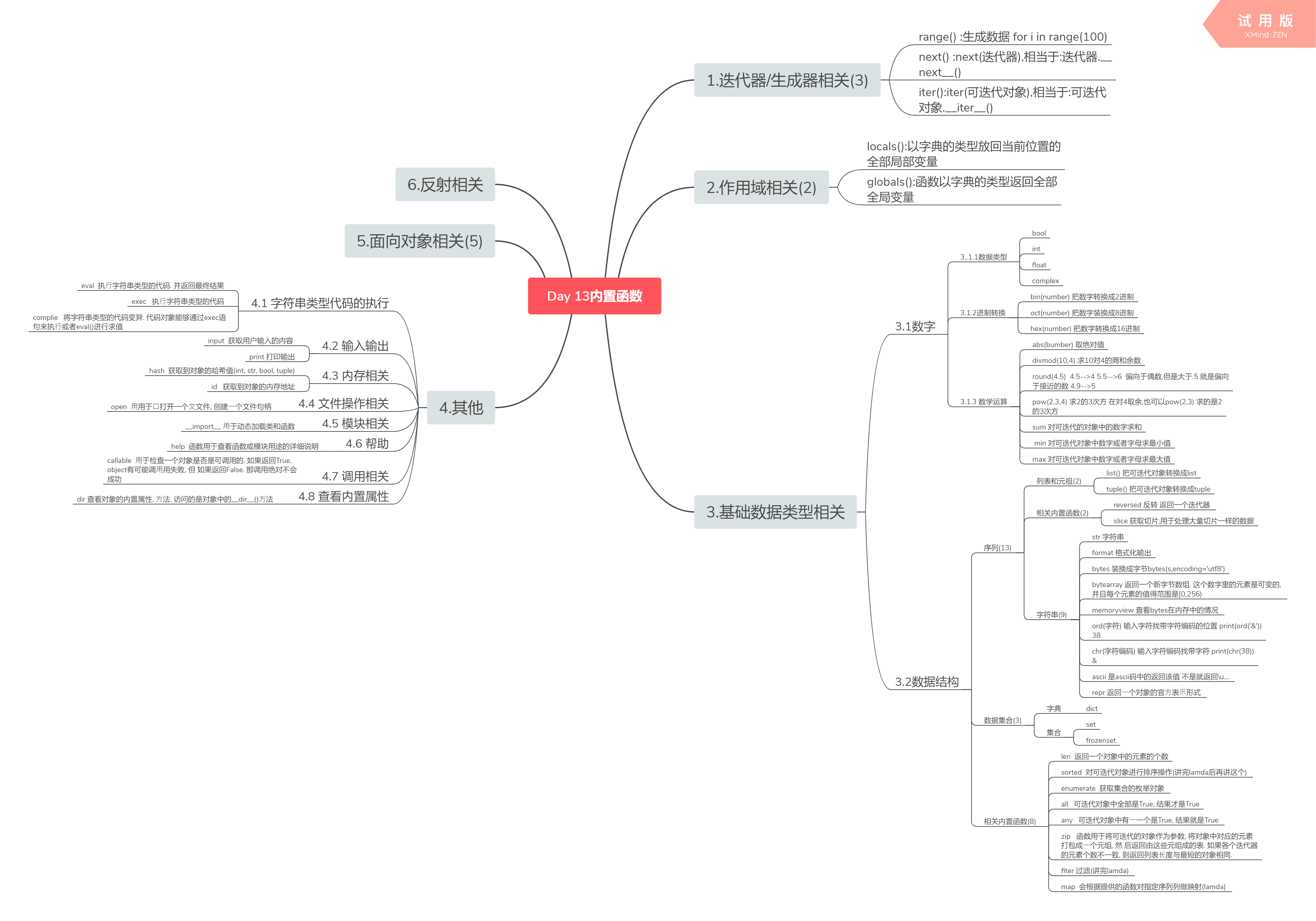
lst = ["唐伯虎", "小娟", "张鹤伦", "烧饼"] # it = lst.__iter__() # print(it.__next__()) # print(it.__next__()) # print(it.__next__()) # print(it.__next__()) # it = iter(lst) # 获取迭代器 # print(it.__next__()) # print(next(it)) # 相当于 __next__() # print(next(it)) # print(next(it)) # s = "胡辣汤" # print(id(s)) # 2175466552560 内存地址的int形式 # print(hash(s)) # 唯一的数字, 为了存储 6492443426362943124 8426701594033488624 # print(hash(s)) # # print(hash(13)) # 数字的哈希值就是它本身 # 4342805289873345757 哈希值不能做密码-> md5 # 4342805289873345757 # 4931740966047962723 # 4931740966047962723 # print(help(str)) # 帮我看看str是啥 # a = 10 # # a() # 不可以被调用 () # # def chi(): # print("吃什么呢") # # chi() # # print(callable(a)) # False # print(callable(chi)) # True # def dai(fn): # if callable(fn): # 判断参数是否可以被调用 # fn() # else: # print("不能被调用") # # dai(10) # print(dir(str)) # 255 255 255 255 # 11111111 11111111 11111111 11111111 # print(bin(256)) # 0b100 1 10 11 100 # print(oct(8)) # 0o10 # print(hex(15)) # 十六进制-> 0-9 abcdef # print(int(0x10)) # 十进制 # float 浮点数 # print(type(0.0112)) # complex 复数 = 实数+虚数 # 实数: 有理数+无理数(无限不循环小数 pi) # i ** 2 = -1 虚无缥缈的数 # matlab # print(abs(3)) # 绝对值. 取模 # # print(divmod(20, 555555555555)) # 不太好用. # print(round(4.4)) # 如果整数位是偶数靠近偶数进行舍弃 - # print(round(5.4)) # 如果整数位是偶数靠近偶数进行舍弃 + # 自定义的 # def func(num): # "5.4123456" ["5", "4123456"] # fu = 1 # if num < 0: # fu = -1 # # num = abs(num) # snum = str(num) # if int(snum.split(".")[1][0])>=5: # 入 # return (int(snum.split(".")[0])+1)*fu # else: # 舍 # return int(snum.split(".")[0])*fu # # print(func(11.99)) # print(pow(10,2,3)) # print(10**2) # 1+2+3+4+5+6+7...100 # print(sum(range(101))) # range(101) 可迭代对象 # sum(可迭代对象) # print(max(1,2,3,-4,5,6,7,8,9)) # print(min(1,2,3,-4,5,6,7,8,9)) # lst = ["哈哈", "呵呵", "吼吼"] # for i in range(len(lst)): # print(i) # print(lst[i]) # for i,el in enumerate(lst, 100): # (索引, 元素) # print(i, el) # lst = ["电脑", "键盘", "鼠标"] # for i, el in enumerate(lst, 1): # print(i, el) # print(all([1,2,True,0])) # False and # print(any([1,'',0])) # True or # zip 拉链函数 # lst1 = ["胡歌", "霍建华", "彭于晏", "吴彦祖"] # lst2 = [37,46,50] # lst3 = ["仙剑三", "花千骨", "湄公河行动", "警察故事"] # # z = zip(lst1, lst2, lst3) # 第0个放一起, 第一个放一起, 第二个放一起. 水桶效应 # print("__iter__" in dir(z)) # 可以迭代 # for el in z: # print(el) # lst = (1,2,3,4,5) # new_lst = reversed(lst) # 通用 # for el in new_lst: # print(el) # s = "哈哈哈哈" # for c in s: # print(c) # # lst = {1,2,3,4,5} # for c in lst: # print(c) # st = "⼤家好, 我是麻花藤" # s = slice(1, 6, 2) # print(st[s]) # st[::] # lst1 = [1,2,3,4,5,6,7,8,9] # lst2 = [1,2,3,4,5,6,7,8,9] # lst3 = [1,2,3,4,5,6,7,8,9] # lst4 = [1,2,3,4,5,6,7,8,9] # lst5 = [1,2,3,4,5,6,7,8,9] # lst6 = [1,2,3,4,5,6,7,8,9] # lst7 = [1,2,3,4,5,6,7,8,9] # lst8 = [1,2,3,4,5,6,7,8,9] # lst9 = [1,2,3,4,5,6,7,8,9] # lst10 = [1,2,3,4,5,6,7,8,9] # lst1[s] # lst1[s] # lst1[s] # lst1[s] # lst1[s] # lst1[s] # lst1[s] # lst1[s] # 字符串 # print(format('test', '<20')) # 左对⻬ cener(20) # print(format('test', '>20')) # 右对⻬ # print(format('test', '^20')) # 居中 # # 数值 # print(format(3, 'b')) # ⼆进制 11 # print(format(97, 'c')) # 转换成unicode字符 a # print(format(11, 'd')) # ⼗进制 11 # print(format(11, 'o')) # ⼋进制 13 # print(format(11, 'x')) # ⼗六进制(⼩写字⺟) b # print(format(11, 'X')) # ⼗六进制(⼤写字⺟) B # print(format(11, 'n')) # 和d⼀样 11 # print(format(11)) # 和d⼀样 11 # # 浮点数 # print(format(123456789, 'e')) # 科学计数法. 默认保留6位⼩数 # print(format(123456789, '0.2e')) # 科学计数法. 保留2位⼩数(⼩写) # print(format(123456789, '0.2E')) # 科学计数法. 保留2位⼩数(⼤写) # print(format(1.23456789, 'f')) # ⼩数点计数法. 保留6位⼩数 # print(format(1.23456789, '0.2f')) # ⼩数点计数法. 保留2位⼩数 # print(format(1.23456789, '0.10f')) # ⼩数点计数法. 保留10位⼩数 # print(format(1.23456789e+10000, 'F')) # ⼩数点计数法. INF 无穷 # 1.2508132548754585 # print(format(1.2508132548754585,"0.2f")) # s = "今天星期五" # print(s.encode("utf-8")) # print(bytes(s, encoding="utf-8")) # 网络通信要用到它 # s = "内存" # m = memoryview(s.encode("utf-8")) # 不给程序员用的 # print(m) # print(ord("中")) # 查看编码位置 # # print(chr(20013)) # 查看某位置的编码是谁 # for i in range(65536): # print(chr(i), end=" ") # print(ascii("中国韩国日本新加坡")) # 判断你的文字是否在ascii里面. 也能获取到unicode # 在字符串中使用\表示的转义 # \n 换行 \t制表符 \r回车 # \\ \ # \" " # \' ' # # python使用的字符串实际上和c的字符串是不一样的. python对字符串进行了处理 # print("你好我叫\\刘德\n华我叫周润发") # # 字符串最应该显示的样子. 最底层, 最官方的显示效果 # print(repr("你好我叫\\刘德\n华我叫周润发")) # __repr__ __str___ # print(r"你给我显\示一下\n") # r"" 原样输出 # print(r"\/\d+\w|\d?*") # name = "胡辣汤" # # 3.6以上 # print(f"我想吃{name}") # f format {占位赋值} # # print("我想吃%s" % name) # code = "1+2+3+5" # ret = eval(code) # 直接执行字符串类型的代码. 有返回值 # print(ret) # code = "n = 16" # exec(code) # print(n) # 16 # code = input("请输入你要执行的代码") # exec(code) # 执行代码. 没有返回值 # exec和eval 都不可以一次性执行大段的代码(字符串). # code="1+2+3+4+5" # c = compile(code, "", mode="eval") # print(eval(c)) # code = """ # for i in range(10): # print(i) # for j in range(10): # print(j) # """ # c = compile(code, "", mode="exec") # exec(c) # 执行代码 # code = """name = input('请输入你的名字')""" # c = compile(code, "", mode="single") # single 有交互 # exec(c) # print(name) # pycharm的提示有的时候是不对的 # 可以把字符串类型的数据转化成具体的某些数据 # qianduan = "[1,2,3,4,5]" # json # lst = eval(qianduan) # print(lst) # 列表